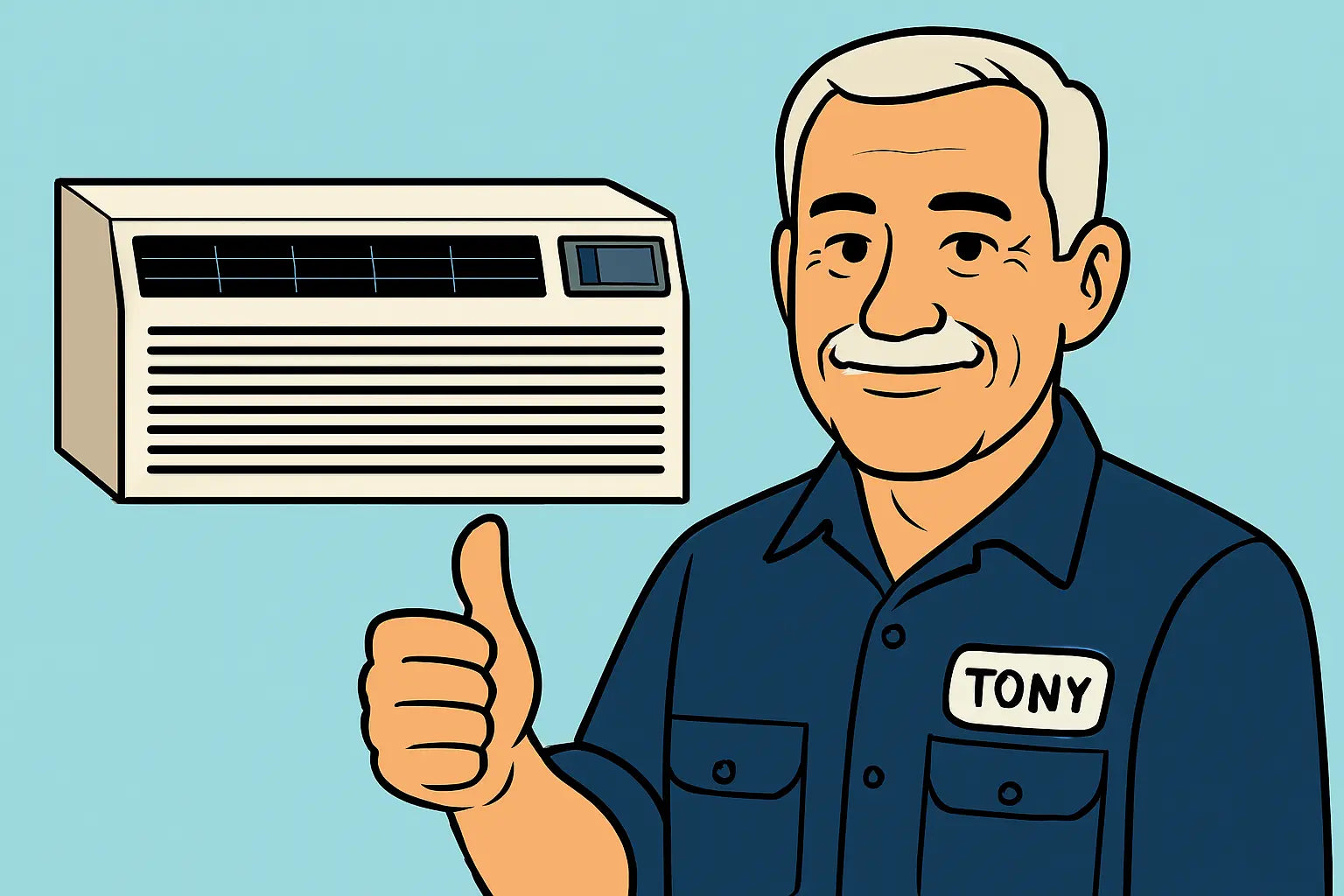🛠️ Introduction: Tony Marino's HVAC Corner
Hey there, Tony Marino here! If you're reading this, you're probably standing in front of your brand-new Amana Distinctions 14,700 BTU PTAC unit, scratching your head and wondering, "Where do I start?" Well, worry no more! With over 25 years in the HVAC game, I've seen it all—from units that refuse to power up to those that blow hot air in the middle of summer. In this guide, I'm going to walk you through everything you need to know to install and troubleshoot your PTAC unit like a pro. Let's dive in!
🔧 Section 1: Installation Made Easy
1.1 Unboxing and Preparation
Before you even think about plugging in your new PTAC unit, let's get it out of the box and ready for installation. Here's what you'll need:
-
Tools: Screwdriver, level, drill, measuring tape
-
Materials: Mounting bracket, sealant, insulation tape
-
Safety Gear: Gloves, safety glasses
Start by carefully removing the unit from its packaging. Check for any visible damage during shipping—better to catch it now than later. Lay out all your tools and materials, and let's get started.
1.2 Choosing the Right Location
Selecting the perfect spot for your PTAC unit is crucial. Consider the following:
-
Height: The unit should be installed at a height that allows for optimal airflow.
-
Accessibility: Ensure easy access for maintenance and filter changes.
-
Clearance: Maintain proper clearance around the unit for efficient operation.
Refer to the Amana PTAC Installation Instructions & Owner's Manual for specific guidelines on placement.
1.3 Mounting the Unit
Follow these steps to mount your PTAC unit securely:
-
Install the Mounting Bracket: Use the provided screws to attach the bracket to the wall.
-
Position the Unit: Carefully lift the unit and place it onto the bracket.
-
Secure the Unit: Fasten the unit to the bracket using the provided screws.
1.4 Electrical Connections
Safety first! If you're not comfortable working with electricity, it's best to hire a licensed electrician. However, if you're doing it yourself:
-
Turn Off Power: Ensure the circuit breaker is off before starting.
-
Connect Wires: Follow the wiring diagram provided in the Amana PTAC Service Instructions Manual.
-
Secure Connections: Tighten all wire connections and check for any loose ends.
Remember, a proper electrical connection is vital for the unit's performance and safety.
1.5 Final Checks
Once everything is installed:
-
Inspect for Leaks: Check around the unit for any signs of air or water leaks.
-
Test Operation: Turn on the unit and test all functions—cooling, heating, fan speeds.
-
Clean Up: Remove any debris and ensure the area around the unit is tidy.
🧰 Section 2: Troubleshooting Common Issues
Even the best units can have hiccups. Here are some common issues and how to fix them:
2.1 Unit Won't Power On
-
Check Power Source: Ensure the unit is plugged in and the circuit breaker is on.
-
Reset the Unit: Follow the steps in the How to Troubleshoot & Reset Your Amana PTAC Unit guide to perform a reset.
2.2 No Cooling or Heating
-
Check Settings: Ensure the unit is set to the desired mode (cool or heat).
-
Inspect Filters: Dirty filters can restrict airflow. Clean or replace them as needed.
-
Check Refrigerant Levels: Low refrigerant can cause performance issues. Consult a professional if needed.
2.3 Strange Noises
-
Identify the Sound: Is it a rattling, buzzing, or grinding noise?
-
Check for Obstructions: Ensure nothing is blocking the fan or vents.
-
Inspect Components: Loose parts or worn-out bearings can cause unusual sounds.
For a comprehensive list of error codes and their meanings, refer to the Complete Guide to Amana PTAC Error Codes.
2.4 Unit Leaking Water
-
Check Drainage: Ensure the unit's drainage system is clear and unobstructed.
-
Inspect Seals: Worn or damaged seals can cause leaks. Replace them as necessary.
🧼 Section 3: Maintenance Tips for Longevity
Regular maintenance can extend the life of your PTAC unit. Here's how:
-
Clean Filters Monthly: Dirty filters can reduce efficiency and air quality.
-
Inspect Coils Annually: Dirty coils can cause the unit to overheat and fail.
-
Check Drainage: Ensure the drainage system is clear to prevent water damage.
🏁 Conclusion: Tony's Final Thoughts
Alright, folks, Tony Marino here again. Installing and troubleshooting your Amana Distinctions 14,700 BTU PTAC unit doesn’t have to be a headache if you follow the steps above. Remember, regular maintenance—like keeping your filters clean and checking drainage—is the secret sauce to keeping your unit running smoothly for years.
If you’re ready to get your hands on this powerhouse PTAC unit or need a reference for parts and specifications, check it out here: Amana Distinctions 14,700 BTU PTAC Unit with Heat Pump and 3.5 kW Electric Heat Backup.
And remember, if you run into issues beyond the basics—like strange noises or persistent leaks—it’s always smart to call a pro. Otherwise, follow the steps I’ve shared, and you’ll have a cool (or toasty) space in no time.
Need more installation tips for this unit? Visit: Insider Tips for a Smooth Amana 14,700 BTU PTAC Setup.
Stay sharp, stay safe, and keep those filters clean! 💪🛠️
- Tony the Trusted Tech







